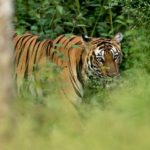Complete List of National Parks & Wildlife Sanctuaries of Himachal Pradesh

Complete List of National Parks & Wildlife Sanctuaries of Himachal Pradesh
Below is the complete list of all wildlife sanctuaries of Punjab including national parks, bird sanctuaries, forest reserves of Himachal Pradesh, India
Download Wildtrails of India app (iOS and Android) to get complete details of each of the sanctuary, kind of animals, birds and reptiles you get to see there, reviews & ratings, near by attractions, how to get there, to navigate there on your mobile, safari details, who to contact, attached accommodations, best time to visit, when closed & when open, all gates/zones info and lot more.
1 Great Himalayan National Park (GHNP)
2 Pin Valley National Park
3 Inderkilla National Park
4 Simbalbara National Park
5 Bandli Wildlife Sanctuary
6 Chail Wildlife Sanctuary
7 Chandratal Wildlife Sanctuary
8 Churdhar Wildlife Sanctuary
9 Daranghati Wildlife Sanctuary
10 Dhauladhar Wildlife Sanctuary (Gopalpur Zoo)
11 Gamgul Siyabehi Wildlife Sanctuary
12 Kais Wildlife Sanctuary
13 Kalatop-Khajjiar Wildlife Sanctuary
14 Kanawar Wildlife Sanctuary
15 Khokhan Wildlife Sanctuary
16 Kibber (Kyibar) Wildlife Sanctuary
17 Kugti Wildlife Sanctuary
18 Lippa Asrang Wildlife Sanctuary
19 Majathal Wildlife Sanctuary
20 Manali Wildlife Sanctuary
21 Nargu Wildlife Sanctuary
22 Pong Dam Lake (Maharana Pratap Sagar) Wildlife Bird Sanctuary
23 Renuka Wildlife Sanctuary
24 Rupi Bhaba Wildlife Sanctuary
25 Sainj Wildlife Sanctuary
26 Sangla Valley (Rakcham Chitkul) Wildlife Sanctuary
27 Sech Tuan Nala Wildlife Sanctuary
28 Shikari Devi Wildlife Sanctuary
29 Shimla Water Catchment Wildlife Sanctuary
30 Talra Wildlife Sanctuary
31 Tundah Wildlife Sanctuary
State Animal of Himachal Pradesh is: Snow leopard
The snow leopard or ounce is a large cat native to the mountain ranges of Central and South Asia. It is listed as Endangered on the IUCN Red List of Threatened Species because, as of 2003, the size of the global wild population was estimated at 4,080–6,590 adults. Fewer than 2,500 individuals may be reproducing in the wild. As of 2016, estimates for the size of the global population vary from at least 4,080 to about 8,700 individuals.
Snow leopards inhabit alpine and subalpine zones at elevations from 3,000 to 4,500 m (9,800 to 14,800 ft). In the northern range countries, they also occur at lower elevations.
Taxonomically, the snow leopard has been classified as Uncia uncia since the early 1930s. Based on genotyping studies, the cat has been considered a member of the genus Panthera since 2008. Two subspecies have been attributed, but genetic differences between the two have not been settled.
Potential snow leopard habitat in the Indian Himalayas is estimated at less than 90,000 km2 (35,000 sq mi) in the states of Jammu and Kashmir, Uttarakhand, Himachal Pradesh, Sikkim, and Arunachal Pradesh, of which about 34,000 km2(13,000 sq mi) is considered good habitat, and 14.4% is protected. In the beginning of the 1990s, the Indian snow leopard population was estimated at roughly 200–600 individuals living across about 25 protected areas
Snow leopards are slightly smaller than the other big cats but, like them, exhibit a range of sizes, generally weighing between 27 and 55 kg (60 and 121 lb), with an occasional large male reaching 75 kg (165 lb) and small female of under 25 kg (55 lb). They have a relatively short body, measuring in length from the head to the base of the tail 75 to 150 cm (30 to 60 in). However, the tail is quite long, at 80 to 100 cm (31 to 39 in), with only the domestic-cat-sized marbled cat being relatively longer-tailed. They are stocky and short-legged big cats, standing about 60 cm (24 in) at the shoulder.
Snow leopards have long, thick fur, and their base color varies from smoky gray to yellowish tan, with whitish underparts. They have dark grey to black open rosettes on their bodies, with small spots of the same color on their heads and larger spots on their legs and tails. Unusually among cats, their eyes are pale green or grey in color.
Snow leopards show several adaptations for living in a cold, mountainous environment. Their bodies are stocky, their fur is thick, and their ears are small and rounded, all of which help to minimize heat loss. Their paws are wide, which distributes their weight better for walking on snow, and have fur on their undersides to increase their grip on steep and unstable surfaces; it also helps to minimize heat loss. Snow leopards’ tails are long and flexible, helping them to maintain their balance, which is very important in the rocky terrain they inhabit. Their tails are also very thick due to fat storage and are very thickly covered with fur, which allows them to be used like a blanket to protect their faces when asleep.
The snow leopard has a short muzzle and domed forehead, containing unusually large nasal cavities that help the animal breathe the thin, cold air of their mountainous environment.
The snow leopard cannot roar, despite possessing partial ossification of the hyoid bone. This partial ossification was previously thought to be essential for allowing the big cats to roar, but new studies show that the ability to roar is due to other morphological features, especially of the larynx, which are absent in the snow leopard. Snow leopard vocalizations include hisses, chuffing, mews, growls, and wailing.
Snow leopards were only reclassified as a member of the Panthera genus (big cats) following a genetic study by Mr Brian Davis, Dr Gang Li and Professor William Murphy in 2009. This study showed that snow leopards actually evolved alongside tigers and not leopards as previously thought.
————————————–
WildTrails (Tm) India App – “One Stop Destination for all Indian Wildlife Enthusiasts“
PS: Please be a responsible wildlife tourist; No littering, No sounds, No feeding, no getting down from the safari jeep (when on safari), No phone calls. Remember that we are visiting their home and when we are there, let’s follow their rules.
[The WildTrails India App is the best way to get all the details about Indian wildlife sanctuaries (best travel times, safari details, animal sightings, forest accommodations pairing, wildlife related activities, prices, etc). Learn more about WildTrails of India here. ios App is here. Android is here, and Web is on the way. Please do like us on our facebook page here.
Download Highway Help App (iOS & Android) which is your friend on the Indian Highways to be your highway friend and companion.
Thanks]
With 4 years of Sightings data + Extensive expert tracker network in jungles, our customers had the best wildlife experiences.
Buy Wildlife Fashion Accessories
Exclusive Online Store for wildlife products
Packages
Packages Loading...
Recent Posts











